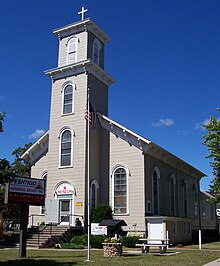User:GhostRiver/peshtigo
Background[edit]
Fire[edit]

Aftermath[edit]

Suspected causes[edit]
The Peshtigo fire coincided with two nearby firestorms on the night of October 8, 1871: the most well-known was the Great Chicago Fire, while Michigan faced the Port Huron Fire of 1871, part of a series of forest fires known as the Great Michigan Fire. Although the proximate cause of the Peshtigo fire remains unknown, a number of contributing factors allowed the firestorm to reach devastating heights.[1] The autumnal months of 1871 proved unusually dry in the Great Lakes region of North America, with only two instances of rain occurring between July and September of the year. Local farmers used these arid conditions to expand their crop fields through slash-and-burn agricultural practices.[2] The Great Lakes region was also known for its lumber industry, with the volume of wood products in the region increasing the probability of wildfires. In addition to these dry conditions and volume of flammable material, the presence of cyclonic windstorms in the area would carry fires easily, affording even small blazes the chance of devastation.[3]
In his 1985 work Mrs. O'Leary's Comet, film director Mel Waskin proposed that the simultaneous blazes in Peshtigo, Chicago, and Manistee were caused by the impact of fragments from Biela's Comet, a theory which has been largely debunked.[4]
Legacy[edit]

Attempts to memorialize the effects of the Peshtigo fire began in 1949, when residents began a drive to institute a state historical marker at the local cemetery. The marker was ordered on September 5, 1950, and was completed by March 1951. After spending a month on display at the Wisconsin State Capitol in Madison, the marker moved to Peshtigo, where it was stored at the City Hall. On October 7, 1951, a dedication ceremony was held at the marker's permanent location, the Peshtigo Fire Cemetery.[5]
See also[edit]
References[edit]
- ^ Hultquist, Tom. "The Great Midwest Fires of 1871". National Weather Service. Retrieved September 25, 2021.
- ^ Leschak 2002, p. 5.
- ^ Penna & Rivers 2013, p. 121.
- ^ Bales, Richard F. (2002). The Great Chicago Fire and the Myth of Mrs. O'Leary's Cow. Jefferson, NC: McFarland & Company, Inc. pp. 101–103. ISBN 0-7864-1424-3. Retrieved October 2, 2021.
- ^ "Peshtigo Cemetery Marker Back After Refurbishing". Peshtigo Times. July 29, 2021. Retrieved September 27, 2021.
Bibliography[edit]
- Gess, Denise; Lutz, William (2002). Firestorm at Peshtigo: A Town, Its People, and the Deadliest Fire in American History. New York, NY: Henry Holt and Company. ISBN 0-8050-6780-9. Retrieved September 25, 2021.
- Leschak, Peter M. (2002). Ghosts of the Fireground: Echoes of the Great Peshtigo Fire and the Calling of a Wildland Firefighter. San Francisco, CA: HarperSanFrancisco. ISBN 0-06-251777-5. Retrieved September 25, 2021.
- Penna, Anthony N.; Rivers, Jennifer S. (2013). "The Chicago and Peshtigo Fires (1871)". Natural Disasters in a Global Environment. West Sussex, UK: John Wiley & Sons, Ltd. pp. 120–131. ISBN 978-1-118-25234-5. Retrieved September 25, 2021.
